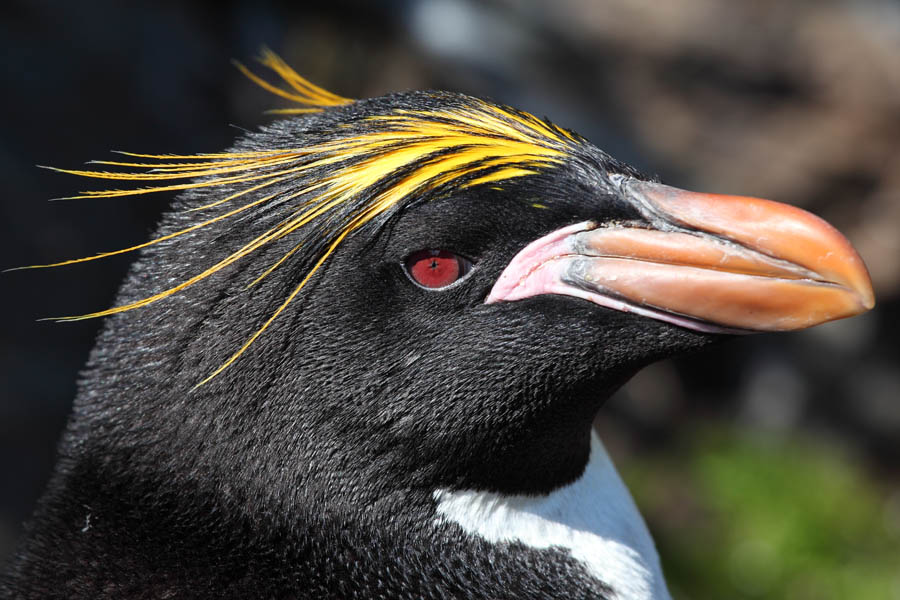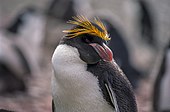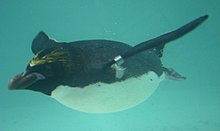Its diet consists of a variety of crustaceans, mainly krill, as well as small fish and cephalopods; the species consumes more marine life annually than any other species of seabird. These birds moult once a year, spending about three to four weeks ashore, before returning to the sea. Numbering up to 100,000 individuals, the breeding colonies of the macaroni penguin are among the largest and densest of all penguin species. After spending the summer breeding, penguins disperse into the oceans for six months; a 2009 study found that macaroni penguins from Kerguelen travelled over 10,000 km (6,200 mi) in the central Indian Ocean. With about 18 million individuals, the macaroni penguin is the most numerous penguin species. However, widespread declines in populations have been recorded since the mid-1970s. Their conservation status is being reclassified as vulnerable.

Taxonomy
The macaroni penguin was described from the Falkland Islands in 1837 by German naturalist Johann Friedrich von Brandt.[3] It is one of six or so species in the genus Eudyptes, collectively known as crested penguins. The genus name is derived from the Ancient Greek words eu "good", and dyptes "diver". The specific epithet chrysolophus is derived from the Greek words chryse "golden", and lophos "crest".[4]The common name was recorded from the early 19th century in the Falkland Islands. English sailors apparently named the species for its conspicuous yellow crest;[5] Maccaronism was a term for a particular style in 18th-century England marked by flamboyant or excessive ornamentation. A person who adopted this fashion was labelled a "maccaroni" or "macaroni", as in the song "Yankee Doodle".[6]
Molecular clock evidence using DNA suggests the macaroni penguin split from its closest relative, the royal penguin (Eudyptes schlegeli), around 1.5 million years ago.[7] Although the two have generally been considered separate species, the close similarities of their DNA sequences has led some, such as the Australian ornithologists Les Christidis and Walter Boles, to treat the royal as a subspecies of the macaroni.[8][9] The two species are very similar in appearance, although the royal penguin has a white face instead of the usually black face of the macaroni.[10] Interbreeding with the Indo-Pacific subspecies of the southern rockhopper penguin (E. chrysocome filholi) has been reported at Heard and Marion Islands, with three hybrids recorded there by a 1987–88 Australian National Antarctic Research Expedition.[11]
Description
Showing the conspicuous orange and yellow crests
Immature birds are distinguished by their smaller size, smaller, duller-brown bill, dark grey chin and throat, and absent or underdeveloped head plumes, often just a scattering of yellow feathers. The crest is fully developed in birds aged three to four years, a year or two before breeding age.[3]
Macaroni penguins moult once a year, a process in which they replace all of their old feathers. They spend around two weeks accumulating fat before moulting because they do not feed during the moult, as they cannot enter the water to forage for food without feathers. The process typically takes three to four weeks, which they spend sitting ashore. Once finished, they go back to sea and return to their colonies to mate in the spring.[14] Overall survival rates are poorly known; the successful return of breeding adults at South Georgia Island varied between 49% and 78% over three years, and around 10% of those that did return did not breed the following year.[15]
Distribution and habitat
Mainly Macaroni penguins, Cooper Bay, South Georgia
Conservation
Skeleton of a Macaroni Penguin in Manchester Museum
Life history
Swimming at Twycross Zoo
Macaroni penguin "porpoising" in Cooper Bay
Diet
The diet of the macaroni penguin consists of a variety of crustaceans, squid and fish, although the proportions that each makes up vary with locality and season. Krill, particularly Antarctic krill (Euphausia superba), account for over 90% of food during breeding season.[30] Cephalopods and small fish such as the marbled rockcod (Notothenia rossii), painted notie (Lepidonotothen larseni), Champsocephalus gunneri, the lanternfish species Krefftichthys anderssoni, Protomyctophum tenisoni and P. normani become more important during chick-rearing.[31] Like several other penguin species, the macaroni penguin sometimes deliberately swallows small (10– to 30-mm-diameter) stones; this behaviour has been speculated to aid in providing ballast for deep-sea diving,[32] or to help grind food, especially the exoskeletons of crustaceans which are a significant part of its diet.[33][34]Foraging for food is generally conducted on a daily basis, from dawn to dusk when they have chicks to feed. Overnight trips are sometimes made, especially as the chicks grow older;[30] a 2008 study that used surgically implanted data loggers to track the movement of the birds showed the foraging trips become longer once the chick-rearing period is over.[35] Birds venture out for 10–20 days during incubation and before the moult.[30] Macaroni penguins are known to be the largest single consumer of marine resources among all of the seabirds, with an estimated take of 9.2 million tonnes of krill a year.[36] Outside the breeding season, macaroni penguins tend to dive deeper, longer, and more efficiently during their winter migration than during the summer breeding season. Year round, foraging dives usually occur during daylight hours, but winter dives are more constrained by daylight due to the shorter days.[37]
Foraging distance from colonies has been measured at around 50 km (31 mi) at South Georgia,[38] offshore over the continental shelf, and anywhere from 59 to 303 kilometres (37 to 188 mi) at Marion Island.[39] Macaroni penguins normally forage at depths of 15 to 70 m (49 to 230 ft), but have been recorded diving down to 100 m (330 ft) on occasions. Some night foraging does occur, but these dives are much shallower, ranging from only 3 to 6 m (9.8 to 19.7 ft) in depth. Dives rarely exceed two minutes in duration.[40] All dives are V-shaped, and no time is spent at the sea bottom; about half the time on a foraging trip is spent diving. Birds have been calculated as catching from 4 to 16 krill or 40 to 50 amphipods per dive.[30]
Predators
The macaroni penguin's predators consist of birds and aquatic mammals. The leopard seal (Hydrurga leptonyx), Antarctic fur seal (Arctocephalus gazella), Subantarctic fur seal (A. tropicalis), and killer whale (Orcinus orca) sometimes hunt adult macaroni penguins in the water. Colonies suffer low rates of predation if undisturbed; predators generally only take eggs and young that have been left unattended or deserted. Skua species, the snowy sheathbill (Chionis alba), and kelp gull (Larus dominicanus) prey on eggs, and skuas and giant petrels also sometimes take chicks.[15]Courtship and breeding
Eudyptes chrysolophus
Adult macaroni penguins typically begin to breed late in October, and lay their eggs in early November.[19] The nest itself is a shallow scrape in the ground which may be lined with some pebbles, stones, or grass, or nestled in a clump of tussock grass (on South Georgia Island).[43] Nests are densely packed, ranging from around 66 cm apart in the middle of a colony to 86 cm at the edges.[43] A fertile macaroni penguin will lay two eggs each breeding season. The first egg to be laid weighs 90–94 g (3.2–3.3 oz), 61–64% the size of the 145–155 g (5.1–5.5 oz) second, and is extremely unlikely to survive.[43] The two eggs together weigh 4.8% of the mother's body weight; the composition of an egg is 20% yolk, 66% albumen, and 14% shell.[44] Like those of other penguin species, the shell is relatively thick to minimise risk of breakage, and the yolk is large, which is associated with chicks born in an advanced stage of development.[45] Some of the yolk remains at hatching and is consumed by the chick in its first few days.[45]
The fate of the first egg is mostly unknown, but studies on the related royal penguin and erect-crested penguin show the female tips the egg out when the larger second egg is laid. The task of incubating the egg is divided into three roughly equal sessions of around 12 days each over a five-week period.[43] The first session is shared by both parents, followed by the male returning to sea, leaving the female alone to tend the egg. Upon the male's return, the female goes off to sea and does not return until the chick has hatched.[41] Both sexes fast for a considerable period during breeding; the male fasts for 37 days after arrival until he returns to sea for around 10 days before fasting while incubating eggs and young for another 36 days, and the female fasts for 42 days from her arrival after the male until late in the incubation period.[46] Both adults lose 36–40% of their body weight during this period.[47] The second egg hatches around 34 days after it is laid. Macaroni penguins typically leave their breeding colony by April or May to disperse into the ocean.[19][48]
Specimen of a Macaroni penguin chick held at Auckland Museum









No comments:
Post a Comment
Note: Only a member of this blog may post a comment.